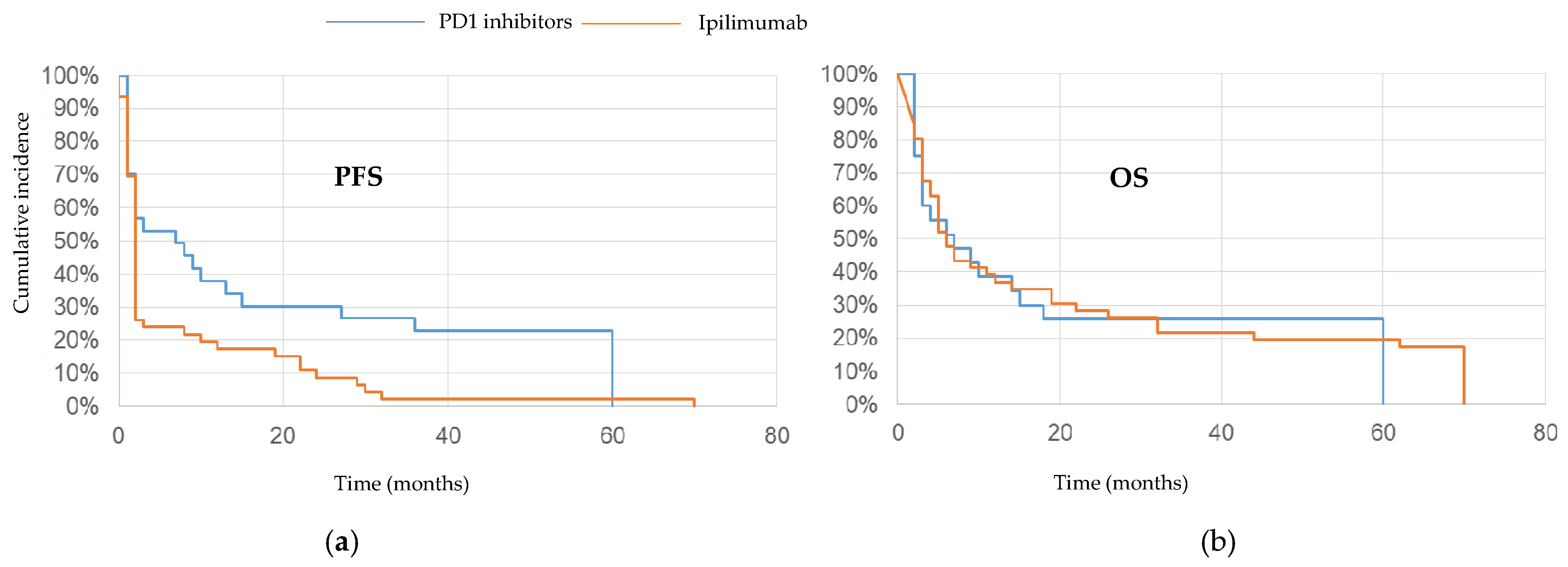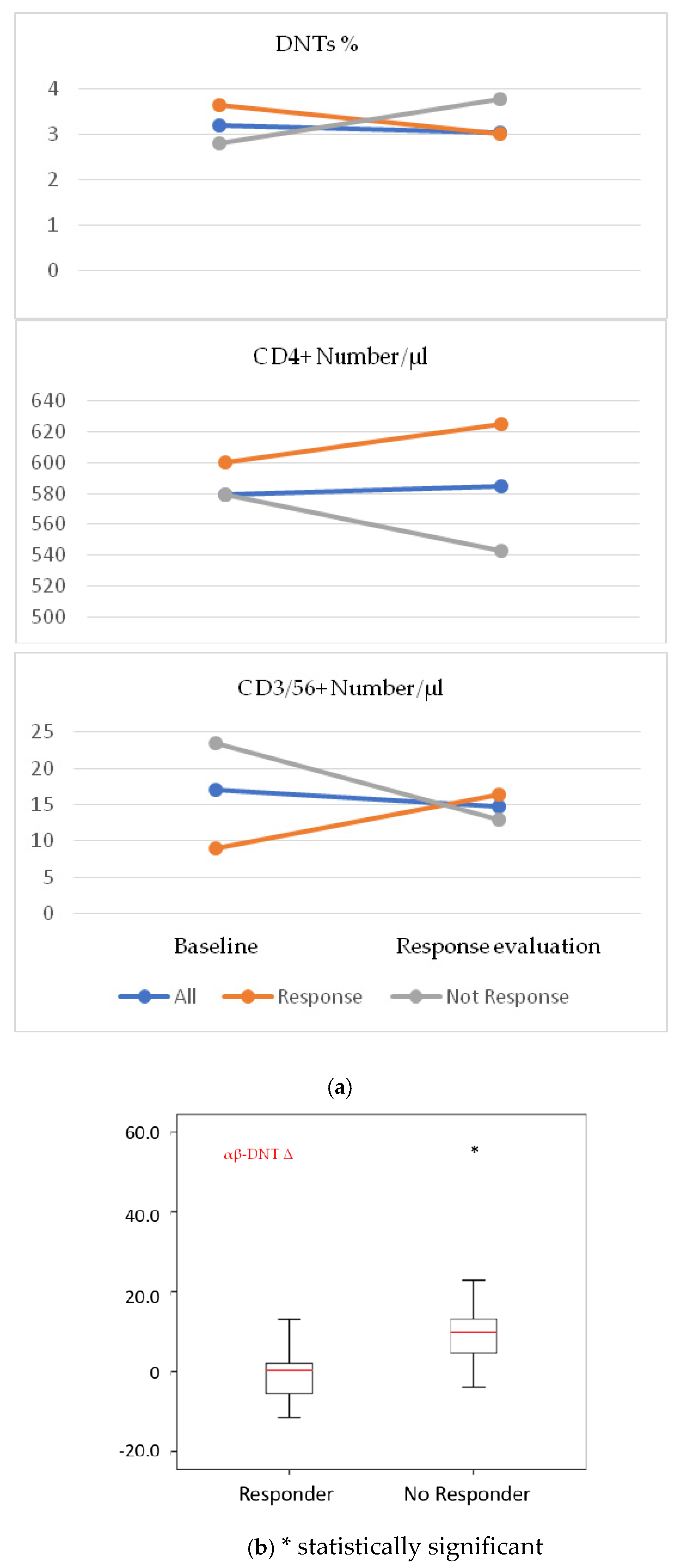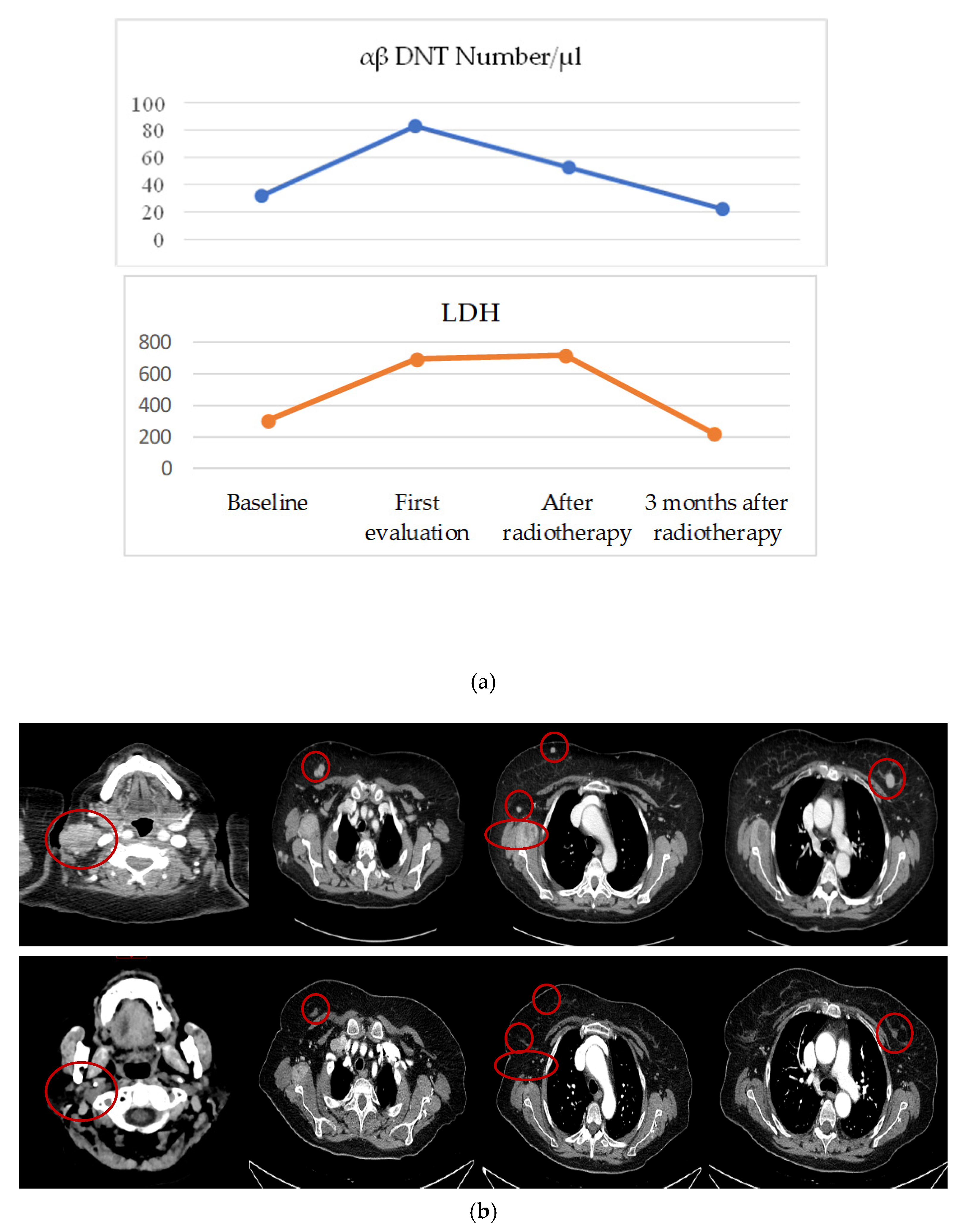Examining the Relationship between Circulating CD4− CD8− Double-Negative T Cells and Outcomes of Immuno-Checkpoint Inhibitor Therapy—Looking for Biomarkers and Therapeutic Targets in Metastatic Melanoma
Abstract
1. Introduction
2. Materials and Methods
2.1. Patients, Treatment and Assessment
2.2. Flow Cytometer Evaluation
2.3. Statistical Analysis
3. Results
3.1. Therapy Outcomes and Correlations with Clinical Features
3.2. Correlation Between the Baseline Value of T Cells, Clinical Features and Therapy Outcomes
3.3. Correlation Between the Change from Baseline T Cells and Therapy Outcomes
4. Discussion
5. Conclusion
Author Contributions
Funding
Institutional Review Board Statement
Informed Consent Statement
Data Availability Statement
Conflicts of Interest
References
- Hodi, F.S.; O’Day, S.J.; McDermott, D.F.; Weber, R.W.; Sosman, J.A.; Haanen, J.B.; Gonzalez, R.; Robert, C.; Schadendorf, D.; Hassel, J.C.; et al. Improved survival with ipilimumab in patients with metastatic melanoma. N. Engl. J. Med. 2010, 363, 711–723. [Google Scholar] [CrossRef]
- Simeone, E.; Gentilcore, G.; Giannarelli, D.; Grimaldi, A.M.; Caracò, C.; Curvietto, M.; Esposito, A.; Paone, M.; Palla, M.; Cavalcanti, E.; et al. Immunological and biological changes during ipilimumab treatment and their potential correlation with clinical response and survival in patients with advanced melanoma. Cancer Immunol. Immunother. 2014, 63, 675–683. [Google Scholar] [CrossRef] [PubMed]
- Martens, A.; Wistuba-Hamprecht, K.; Yuan, J.; Postow, M.A.; Wong, P.; Capone, M.; Madonna, G.; Khammari, A.; Schilling, B.; Sucker, A.; et al. Increases in Absolute Lymphocytes and Circulating CD4+ and CD8+ T Cells Are Associated with Positive Clinical Outcome of Melanoma Patients Treated with Ipilimumab. Clin. Cancer Res. 2016, 22, 4848–4858. [Google Scholar] [CrossRef] [PubMed]
- Weide, B.; Martens, A.; Hassel, J.C.; Berking, C.; Postow, M.A.; Bisschop, K.; Simeone, E.; Mangana, J.; Schilling, B.; Di Giacomo, A.M.; et al. Baseline Biomarkers for Outcome of Melanoma Patients Treated with Pembrolizumab. Clin. Cancer Res. 2016, 22, 5487–5496. [Google Scholar] [CrossRef]
- Diem, S.; Kasenda, B.; Spain, L.; Martin-Liberal, J.; Marconcini, R.; Gore, M.; Larkin, J. Serum lactate dehydrogenase as an early marker for outcome in patients treated with anti-PD-1 therapy in metastatic melanoma. Br. J. Cancer 2016, 114, 256–261. [Google Scholar] [CrossRef]
- Guida, M.; Bartolomeo, N.; De Risi, I.; Fucci, L.; Armenio, A.; Filannino, R.; Ruggieri, E.; Macina, F.; Traversa, M.; Nardone, A.; et al. The Management of Oligoprogression in the Landscape of New Therapies for Metastatic Melanoma. Cancers 2019, 11, 1559. [Google Scholar] [CrossRef]
- Postow, M.A.; Chasalow, S.D.; Kuk, D.; Panageas, K.S.; Cheng, M.L.; Yuan, J.; Wolchok, J.D. Absolute lymphocyte count as a prognostic biomarker for overall survival in patients with advanced melanoma treated with ipilimumab. Melanoma Res. 2020, 30, 71–75. [Google Scholar] [CrossRef] [PubMed]
- Zhang, Z.X.; Young, K.; Zhang, L. CD3+CD4-CD8- alphabeta-TCR+ T cell as immune regulatory cell. J. Mol. Med. Berl. 2001, 79, 419–427. [Google Scholar] [CrossRef]
- D’Acquisto, F.; Crompton, T. CD3+CD4-CD8- (double negative) T cells: Saviours or villains of the immune response? Biochem. Pharmacol. 2011, 82, 333–340. [Google Scholar] [CrossRef]
- Juvet, S.C.; Zhang, L. Double negative regulatory T cells in transplantation and autoimmunity: Recent progress and future directions. J. Mol. Cell Biol. 2012, 4, 48–58. [Google Scholar] [CrossRef]
- Lee, J.; Minden, M.D.; Chen, W.C.; Streck, E.; Chen, B.; Kang, H.; Arruda, A.; Ly, D.; Der, S.D.; Kang, S.; et al. Allogeneic Human Double Negative T Cells as a Novel Immunotherapy for Acute Myeloid Leukemia and Its Underlying Mechanisms. Clin. Cancer Res. 2018, 24, 370–382. [Google Scholar] [CrossRef] [PubMed]
- Yao, J.; Ly, D.; Dervovic, D.; Fang, L.; Lee, J.B.; Kang, H.; Wang, Y.H.; Pham, N.A.; Pan, H.; Tsao, M.S.; et al. Human double negative T cells target lung cancer via ligand-dependent mechanisms that can be enhanced by IL-15. J. Immunother. Cancer 2019, 7, 17. [Google Scholar] [CrossRef] [PubMed]
- Fang, L.; Ly, D.; Wang, S.S.; Lee, J.B.; Kang, H.; Xu, H.; Yao, J.; Tsao, M.S.; Liu, W.; Zhang, L. Targeting late-stage non-small cell lung cancer with a combination of DNT cellular therapy and PD-1 checkpoint blockade. J. Exp. Clin. Cancer Res. 2019, 38, 123. [Google Scholar] [CrossRef] [PubMed]
- Lu, Y.; Hu, P.; Zhou, H.; Yang, Z.; Sun, Y.U.; Hoffman, R.M.; Chen, J. Double-negative T Cells Inhibit Proliferation and Invasion of Human Pancreatic Cancer Cells in Co-culture. Anticancer Res. 2019, 39, 5911–5918. [Google Scholar] [CrossRef] [PubMed]
- Hillhouse, E.E.; Thiant, S.; Moutuou, M.M.; Lombard-Vadnais, F.; Parat, R.; Delisle, J.S.; Ahmad, I.; Roy, D.C.; Guimond, M.; Roy, J.; et al. Double-Negative T Cell Levels Correlate with Chronic Graft-versus-Host Disease Severity. Biol. Blood Marrow Transpl. 2019, 25, 19–25. [Google Scholar] [CrossRef]
- Alexander, J.J.; Jacob, A.; Chang, A.; Quigg, R.J.; Jarvis, J.N. Double negative T cells, a potential biomarker for systemic lupus erythematosus. Precis. Clin. Med. 2020, 3, 34–43. [Google Scholar] [CrossRef] [PubMed]
- Voelkl, S.; Moore, T.V.; Rehli, M.; Nishimura, M.I.; Mackensen, A.; Fischer, K. Characterization of MHC class-I restricted TCRalphabeta+ CD4- CD8- double negative T cells recognizing the gp100 antigen from a melanoma patient after gp100 vaccination. Cancer Immunol. Immunother. 2009, 58, 709–718. [Google Scholar] [CrossRef]
- De Tullio, G.; Strippoli, S.; Angarano, R.; De Fazio, V.; Sgherza, N.; Negri, A.; Albano, A.; Iacopino, P.; Guarini, A.; Guida, M. αβ-Double Negative CD4/CD8 (CD56) T cell (DNTs) in metastatic melanoma: Basal frequency and behaviour during Ipilimumab treatment. Preliminary evaluations. J. Transl. Med. 2015, 15 (Suppl. 1), O10. [Google Scholar] [CrossRef]
- Vallacchi, V.; Vergani, E.; Camisaschi, C.; Deho, P.; Cabras, A.D.; Sensi, M.; De Cecco, L.; Bassani, N.; Ambrogi, F.; Carbone, A.; et al. Transcriptional profiling of melanoma sentinel nodes identify patients with poor outcome and reveal an association of CD30(+) T lymphocytes with progression. Cancer Res. 2014, 74, 130–140. [Google Scholar] [CrossRef]
- Greenplate, A.R.; McClanahan, D.D.; Oberholtzer, B.K.; Doxie, D.B.; Roe, C.E.; Diggins, K.E.; Leelatian, N.; Rasmussen, M.L.; Kelley, M.C.; Gama, V.; et al. Computational Immune Monitoring Reveals Abnormal Double-Negative T Cells Present across Human Tumor Types. Cancer Immunol. Res. 2019, 7, 86–99. [Google Scholar] [CrossRef]
- Seymour, L.; Bogaerts, J.; Perrone, A.; Ford, R.; Schwartz, L.H.; Mandrekar, S.; Lin, N.U.; Litière, S.; Dancey, J.; Chen, A.; et al. iRECIST: Guidelines for response criteria for use in trials testing immunotherapeutics. Lancet Oncol. 2017, 18, e143–e152. [Google Scholar] [CrossRef]
- Hillhouse, E.E.; Delisle, J.S.; Lesage, S. Immunoregulatory CD4(-)CD8(-) T cells as a potential therapeutic tool for transplantation, autoimmunity, and cancer. Front. Immunol. 2013, 24, 6. [Google Scholar] [CrossRef]
- Amin, M.B.; Edge, S.; Greene, F.; Byrd, D.R.; Brookland, R.K.; Washington, M.K.; Gershenwald, J.E.; Compton, C.C.; Hess, K.R.; Sullivan, D.C.; et al. The American Joint Committee on Cancer. Melanoma of the Skin. AJCC Cancer Staging Manual, 8th ed.; Springer: New York, NY, USA, 2016. [Google Scholar]
- Fischer, K.; Voelkl, S.; Heymann, J.; Przybylski, G.K.; Mondal, K.; Laumer, M.; Kunz-Schughart, L.; Schmidt, C.A.; Andreesen, R.; Mackensen, A. Isolation and characterization of human antigen-specific TCR alpha beta+ CD4(-)CD8- double-negative regulatory T cells. Blood 2005, 105, 2828–2835. [Google Scholar] [CrossRef]
- Priatel, J.J.; Utting, O.; Teh, H.S. TCR/self-antigen interactions drive double-negative T cell peripheral expansion and differentiation into suppressor cells. J. Immunol. 2001, 167, 6188–6194. [Google Scholar] [CrossRef]
- Zhang, D.; Yang, W.; Degauque, N.; Tian, Y.; Mikita, A.; Zheng, X.X. New differentiation pathway for double-negative regulatory T cells that regulates the magnitude of immune responses. Blood 2007, 109, 4071–4079. [Google Scholar] [CrossRef] [PubMed]
- Feyler, S.; von Lilienfeld-Toal, M.; Jarmin, S.; Marles, L.; Rawstron, A.; Ashcroft, A.J.; Owen, R.G.; Selby, P.J.; Cook, G. CD4(+)CD25(+)FoxP3(+) regulatory T cells are increased whilst CD3(+)CD4(-)CD8(-)alphabetaTCR(+) Double Negative T cells are decreased in the peripheral blood of patients with multiple myeloma which correlates with disease burden. Br. J. Haematol. 2009, 144, 686–695. [Google Scholar] [CrossRef] [PubMed]
- Long, G.V.; Flaherty, K.T.; Stroyakovskiy, D.; Gogas, H.; Levchenko, E.; de Braud, F.; Larkin, J.; Garbe, C.; Jouary, T.; Hauschild, A.; et al. Dabrafenib plus trametinib versus dabrafenib monotherapy in patients with metastatic BRAF V600E/K-mutant melanoma: Long-term survival and safety analysis of a phase 3 study. Ann. Oncol. 2017, 28, 1631–1639. [Google Scholar] [CrossRef]
- Capone, M.; Giannarelli, D.; Mallardo, D.; Madonna, G.; Festino, L.; Grimaldi, A.M.; Vanella, V.; Simeone, E.; Paone, M.; Palmieri, G.; et al. Baseline neutrophil-to-lymphocyte ratio (NLR) and derived NLR could predict overall survival in patients with advanced melanoma treated with nivolumab. J. Immunother. Cancer 2018, 6, 74. [Google Scholar] [CrossRef] [PubMed]
- Strudel, M.; Festino, L.; Vanella, V.; Beretta, M.; Marincola, F.M.; Ascierto, P.A. Melanoma: Prognostic Factors and Factors Predictive of Response to Therapy. Curr. Med. Chem. 2020, 27, 2792–2813. [Google Scholar] [CrossRef]
- Carlino, M.S.; Haydu, L.E.; Kakavand, H.; Menzies, A.M.; Hamilton, A.L.; Yu, B.; Ng, C.C.; Cooper, W.A.; Thompson, J.F.; Kefford, R.F.; et al. Correlation of BRAF and NRAS mutation status with outcome, site of distant metastasis and response to chemotherapy in metastatic melanoma. Br. J. Cancer 2014, 111, 292–299. [Google Scholar] [CrossRef]
- Wistuba-Hamprecht, K.; Martens, A.; Heubach, F.; Romano, E.; Geukes Foppen, M.; Yuan, J.; Postow, M.; Wong, P.; Mallardo, D.; Schilling, B.; et al. Peripheral CD8 effector-memory type 1 T-cells correlate with outcome in ipilimumab-treated stage IV melanoma patients. Eur. J. Cancer 2017, 73, 61–70. [Google Scholar] [CrossRef] [PubMed]
- Stankovic, B.; Bjørhovde, H.A.K.; Skarshaug, R.; Aamodt, H.; Frafjord, A.; Müller, E.; Hammarström, C.; Beraki, K.; Bækkevold, E.S.; Woldbæk, P.R.; et al. Immune Cell Composition in Human Non-small Cell Lung Cancer. Front. Immunol. 2019, 9, 3101. [Google Scholar] [CrossRef] [PubMed]
- Zhang, Z.X.; Ma, Y.; Wang, H.; Arp, J.; Jiang, J.; Huang, X.; He, K.M.; Garcia, B.; Madrenas, J.; Zhong, R. Double-negative T cells, activated by xenoantigen, lyse autologous B and T cells using a perforin/granzyme-dependent, Fas-Fas ligand-independent pathway. J. Immunol. 2006, 177, 6920–6929. [Google Scholar] [CrossRef]
- Ford McIntyre, M.S.; Gao, J.F.; Li, X.; Naeini, B.M.; Zhang, L. Consequences of double negative regulatory T cell and antigen presenting cell interaction on immune response suppression. Int. Immunopharmacol. 2011, 11, 597–603. [Google Scholar] [CrossRef]
- Gao, J.F.; McIntyre, M.S.; Juvet, S.C.; Diao, J.; Li, X.; Vanama, R.B.; Mak, T.W.; Cattral, M.S.; Zhang, L. Regulation of antigen-expressing dendritic cells by double negative regulatory T cells. Eur. J. Immunol. 2011, 41, 2699–2708. [Google Scholar] [CrossRef] [PubMed]
- Su, Y.; Huang, X.; Wang, S.; Min, W.P.; Yin, Z.; Jevnikar, A.M.; Zhang, Z.X. Double negative Treg cells promote nonmyeloablative bone marrow chimerism by inducing T-cell clonal deletion and suppressing NK cell function. Eur. J. Immunol. 2012, 42, 1216–1225. [Google Scholar] [CrossRef]



| Feature | % (n = 68) |
|---|---|
| Age | |
| Median (interquartile range) years | 65 (34–85) |
| Sex | |
| Female | 43 (29) |
| Male | 57 (39) |
| Type of melanoma | |
| Cutaneous | 79 (54) |
| Mucosal | 3 (2) |
| Uveal | 4 (3) |
| Unknown origin | 14 (9) |
| BRAF V600 mutation | 53 (36) |
| NRAS Q61 mutation | 10 (7) |
| TNM stage at diagnosis | |
| II | 44 (30) |
| III | 38 (26) |
| IV | 18 (12) |
| Median Disease Free Survival (months) | 19 (0–144) |
| M stage | |
| M1a | 21 (14) |
| M1b | 14 (10) |
| M1c | 47 (32) |
| M1d | 18 (12) |
| Number of metastatic sites | |
| < 3 | 41 (28) |
| ≥3 | 59 (40) |
| ECOG | |
| 0 | 31 (21) |
| 1 | 48 (33) |
| 2 | 21 (14) |
| LDH | |
| <ULN * | 47 (32) |
| ≥ULN | 53 (36) |
| Line of systemic treatment | |
| Ipilimumab cohort | |
| As first line | 40 (19) |
| As second line | 60 (29) |
| PD1 inhibitors cohort | |
| As second line | 50 (10) |
| As third line | 50 (10) |
| ECOG (**) | |||||
|---|---|---|---|---|---|
| 0 | 1 | 2 | Total | ||
| CR/PR | 10 (58.8%) | 7 (41.2%) | 0 (0%) | 17 (100%) | |
| PD | 8 (18.6%) | 21 (48.8%) | 14 (32.6%) | 43 (100%) | |
| Total | 18 (30.0%) | 28 (46.7%) | 14 (23.3%) | 60 (100%) | |
| Number of Metastatic Sites (*) | |||||
| CR/PR | < 3 | ≥3 | Total | ||
| 9 (52.9%) | 8 (47.1%) | 17 (100%) | |||
| PD | 13 (30.2%) | 30 (69.8%) | 43 (100%) | ||
| Total | 22 (36.7%) | 38 (63.3%) | 60 (100%) | ||
| Age (*) | |||||
| CR/PR | 72 (64–76) | ||||
| PD | 64 (54–72) | ||||
| Features | PFS (Months) |
|---|---|
| MStage | |
| M1a | 8 (3–30) |
| M1b | 3 (3–36.5) |
| M1c | 3 (2–3) |
| M1d | 2 (2–3) |
| ECOG | |
| 0 | 9 (3–32) |
| 1 | 3 (2–5) |
| 2 | 2 (2–3) |
| LDH | |
| <ULN | 3 (3–27) |
| ≥ULN | 3 (2–3) |
| Numberof Metastatic Sites | |
| < 3 | 3 (3–24) |
| ≥3 | 3 (2–3) |
| Features | OS (Months) |
|---|---|
| M Stage | |
| M1a | 48 (4–63) |
| M1b | 16.6 (6.5–62.5) |
| M1c | 6 (3–32) |
| M1d | 4 (2–6) |
| ECOG | |
| 0 | 41 (7–70) |
| 1 | 7 (4–29) |
| 2 | 3 (2–4) |
| LDH | |
| <ULN | 10 (6–62) |
| ≥ULN | 4 (3–18) |
| Number of Metastatic Sites | |
| < 3 | 12.5 (4–62) |
| ≥3 | 6 (3–22) |
| Mutation Status | |
| BRAF/NRAS wt | 6 (3.5–20.5) |
| BRAF V600 | 6 (3–12) |
| NRAS Q61 | 60 (48–62) |
| Features | DNT Absolute Number/µL | DNT Percentage among Lymphocytes | DNT Percentage among CD3+ Cells |
|---|---|---|---|
| Mutational status | (*) | ||
| BRAF/NRAS wild type | 29.27 (19.17–50.82) | ||
| BRAF V600 | 65.69 (23.32–101.33) | ||
| NRAS Q61 | 37.64 (26.49–101.19) | ||
| LDH | (**) | (**) | (**) |
| <ULN | 48.05 (23.46–106.99) | 3.59 (1.94–7.06) | 5.20 (3.33–10.05) |
| ≥ULN | 28.57 (19.26–62.68) | 2.22 (1.44–4.01) | 3.13 (2.06–5.65) |
| ECOG | (**) | ||
| 0 | 68.47 (28.57–106.99) | ||
| 1 | 30.58 (19.24–80.74) | ||
| 2 | 26.51 (9.57–30.90) | ||
| Number of metastatic sites | (*) | ||
| < 3 | 35.81 (101.34–169.32) | ||
| ≥3 | 28.65 (71.09–167.90) |
| Overall Response Rate | |||
|---|---|---|---|
| WBC/µL | %LY | CD3/56% | |
| CR/PR | 6390 (5670–6850) | 22.68 (18.91–26.16) | 0.6 (0.2–2.5) |
| PD | 8158 (5680–11,450) | 15.4 (12.43–21.54) | 1.5 (0.43–4.1) |
| Overall Response Rate | ||
|---|---|---|
| %LY Δ (*) | Absolute Number DNT Δ (*) | |
| CR/PR | −0.87 (−5.70–6.74) | 2.02 (−25.86–23.24) |
| PD | 3.13 (−0.04–7.80) | −0.43 (−11.91–9.18) |
Publisher’s Note: MDPI stays neutral with regard to jurisdictional claims in published maps and institutional affiliations. |
© 2021 by the authors. Licensee MDPI, Basel, Switzerland. This article is an open access article distributed under the terms and conditions of the Creative Commons Attribution (CC BY) license (http://creativecommons.org/licenses/by/4.0/).
Share and Cite
Strippoli, S.; Fanizzi, A.; Negri, A.; Quaresmini, D.; Nardone, A.; Armenio, A.; Sciacovelli, A.M.; Massafra, R.; De Risi, I.; De Tullio, G.; et al. Examining the Relationship between Circulating CD4− CD8− Double-Negative T Cells and Outcomes of Immuno-Checkpoint Inhibitor Therapy—Looking for Biomarkers and Therapeutic Targets in Metastatic Melanoma. Cells 2021, 10, 406. https://doi.org/10.3390/cells10020406
Strippoli S, Fanizzi A, Negri A, Quaresmini D, Nardone A, Armenio A, Sciacovelli AM, Massafra R, De Risi I, De Tullio G, et al. Examining the Relationship between Circulating CD4− CD8− Double-Negative T Cells and Outcomes of Immuno-Checkpoint Inhibitor Therapy—Looking for Biomarkers and Therapeutic Targets in Metastatic Melanoma. Cells. 2021; 10(2):406. https://doi.org/10.3390/cells10020406
Chicago/Turabian StyleStrippoli, Sabino, Annarita Fanizzi, Antonio Negri, Davide Quaresmini, Annalisa Nardone, Andrea Armenio, Angela Monica Sciacovelli, Raffaella Massafra, Ivana De Risi, Giacoma De Tullio, and et al. 2021. "Examining the Relationship between Circulating CD4− CD8− Double-Negative T Cells and Outcomes of Immuno-Checkpoint Inhibitor Therapy—Looking for Biomarkers and Therapeutic Targets in Metastatic Melanoma" Cells 10, no. 2: 406. https://doi.org/10.3390/cells10020406
APA StyleStrippoli, S., Fanizzi, A., Negri, A., Quaresmini, D., Nardone, A., Armenio, A., Sciacovelli, A. M., Massafra, R., De Risi, I., De Tullio, G., Albano, A., & Guida, M. (2021). Examining the Relationship between Circulating CD4− CD8− Double-Negative T Cells and Outcomes of Immuno-Checkpoint Inhibitor Therapy—Looking for Biomarkers and Therapeutic Targets in Metastatic Melanoma. Cells, 10(2), 406. https://doi.org/10.3390/cells10020406







